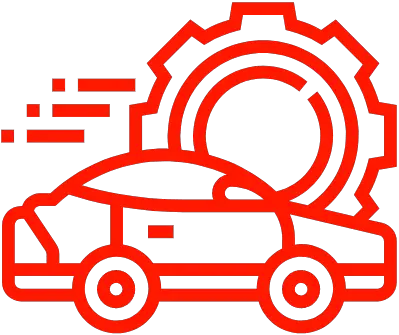How to Diagnose the Cause of a Shredded Serpentine Belt
A serpentine belt is a long, continuous belt used to transmit power from the engine’s crankshaft to other components in the car. This belt, when maintained properly, can last for many years. However, there are a few reasons why it may become shredded or damaged.
Common causes of a shredded serpentine belt include:
1. Wear and tear – Over time, serpentine belts may become worn out due to the heat generated by the engine and regular use. This can cause cracks or fraying in the belt material, leading to its eventual tearing or shredding.
2. Misalignment – If the serpentine belt is not properly aligned on the pulleys it runs over, it can cause excessive friction and wear on the sides of the belt, causing it to shred prematurely.
3. Tension – If the tension of the serpentine belt is too low or too high it can cause damage to its structure and cause it to shred over time.
4. Contamination – The presence of oil or grease on a serpentine belt can reduce its grip on pulleys and cause premature shredding due to slipping and sliding over them.
5. Aggressive driving – Aggressive driving behaviours such as rapid acceleration, hard braking and sharp turns put additional strain on your serpentine belt which can lead to premature shredding or tearing if not properly maintained.
Common Causes of a Shredded Serpentine Belt in an Automobile
There are several common causes of a shredded serpentine belt in an automobile. Excessive wear and tear is one of the most common causes, as the belt’s components are subjected to extreme heat and tension over time. This can eventually cause the belt to break down and shred. Improper installation of the serpentine belt can also cause it to shred; it must be installed correctly with the proper tension for optimal performance. Defective design or weak materials used in manufacturing can also contribute to premature breakdown of the belt. Finally, incorrect tensioning of the serpentine belt can also lead to it shredding prematurely.
Unusual Causes of a Shredded Serpentine Belt in an Automobile
In addition to the standard causes, there are other less common ones that can lead to a shredded serpentine belt in an automobile. Overheating is one such cause, as exposure to high temperatures can damage the rubber material and cause it to break down faster than usual. Contamination from fluid leaks, such as oil or coolant, can also accelerate wear on the serpentine belt and result in shredding. Electrical system malfunctions may also be responsible for accelerated breakdown of the belt due to arcing or sparking that occurs near its components.
Signs Of A Failing Serpentine Belt In An Automobile
It is important for car owners to be aware of both visual and audible signs that their serpentine belt may be failing. Visually, cracking or fraying belts should be immediately addressed as these are clear signs that replacement is needed soon. Additionally, glazing on the surface of the belt indicates excessive friction due to incorrect tensioning or misalignment between parts; this should also warrant immediate attention from a professional mechanic if noticed. Audibly, squealing noises when starting up the engine are indicative that something is wrong with either your serpentine belts or another component related to them; rattling and chirping sounds under the hood may also indicate a problem with your belts and should not be ignored.
Performance Issues Of A Failing Serpentine Belt In An Automobile
Aside from visual and audible cues, there are other performance issues associated with failing serpentine belts in automobiles. Diminished acceleration performance may occur when too much tension has been placed on your belts; this can lead to reduced torque output from your engine, resulting in slower acceleration speeds than usual when you press down on your accelerator pedal. Additionally, reduced power steering efficiency may arise if your belts have become too loose; this will result in stiffer steering wheel movement than usual when turning corners or making tight maneuvers around objects on roads or parking lots.
What Would Cause a Serpentine Belt to Shred?
The serpentine belt is an important component in an automobile, responsible for powering multiple accessories. A belt that has become frayed or worn can cause damage to the engine and other components, as well as cause the vehicle to stall. It is important to inspect and replace a shredded serpentine belt as soon as possible.
Inspecting the Belt
One of the first steps when inspecting a serpentine belt is to check for wear and tear. Look for any signs of fraying or cracking on the surface of the belt. If there are any loose connections, these should be tightened or replaced before continuing with an inspection. Additionally, it is important to identify any contaminants that may be present on the surface of the belt, as these can reduce its lifespan and increase the chances of it shredding.
Testing Components
To ensure that everything is running smoothly, it is important to verify proper tension settings on all components connected to the serpentine belt. This includes testing alternator output voltage, examining power steering pump functionality, and checking all accessory pulleys for proper alignment and tension level.
Replacing a Shredded Serpentine Belt in an Automobile
When replacing a shredded serpentine belt in an automobile, it is important to first prepare by gathering all necessary tools and supplies, including a new serpentine belt and disconnecting battery cables for safety reasons. Installing a new serpentine belt will involve loosening the tensioner pulley before slipping it on over accessory pulleys and securing components with bolts before finalizing installation by reconnecting battery cables and starting up the engine. Adjusting tension as needed will ensure optimal performance from this essential component.
Preventative Maintenance Tips for Avoiding Serpentine Belt Damage in an Automobile
To prevent damage from occurring in the first place, there are some simple steps you can take when performing preventative maintenance on your vehicle’s serpentine belt system. This includes regularly checking for signs of wear or damage on both belts and pulleys; ensuring all connections are securely fastened; visually inspecting for contaminants; checking fluid levels; replacing filters; keeping drive belts clean; and regularly lubricating moving parts with oil or grease as necessary. Taking these steps will help extend your automobile’s lifespan while avoiding costly repairs from shredded belts in the future!
FAQ & Answers
Q: What is a serpentine belt?
A: The serpentine belt is a single, continuous belt used to drive multiple peripheral devices in an automobile engine, such as the alternator, power steering pump, water pump, and air conditioning compressor.
Q: What causes a serpentine belt to shred?
A: The most common causes of a shredded serpentine belt are excessive wear and tear, improper installation, defective design, incorrect tensioning, overheating, contamination from fluid leaks, and electrical system malfunction.
Q: What are the signs of a failing serpentine belt?
A: Signs of a failing serpentine belt can include visual cues such as cracking or fraying belts and glazing on the belt surface. Audible indicators may include squealing noises when starting the engine or rattling or chirping sounds under the hood. Performance issues may include diminished acceleration performance or reduced power steering efficiency.
Q: How do you troubleshoot a shredded serpentine belt?
A: Troubleshooting a shredded serpentine belt involves inspecting the belt for wear and tear, examining for loose connections, identifying contaminants on the surface; testing components such as verifying proper tension settings and testing alternator output voltage; and examining power steering pump functionality.
Q: How do you replace a shredded serpentine belt?
A: Replacing a shredded serpentine belt involves preparing for replacement by gathering tools and supplies and disconnecting battery cables; installing the new belt by loosening the tensioner pulley, slipping on the new serpentine belt and securing components and tightening bolts; and finalizing installation by reconnecting battery cables starting and testing the engine and adjusting belt tension as needed.
A serpentine belt can shred for a variety of reasons, but the most common causes are age, tension, and misalignment. Over time, the belt can become brittle and worn out due to exposure to heat, oil and other environmental factors. If the tension on the belt is too high or too low, this can also cause it to break or shred. Lastly, if the pulleys or components that the belt is connected to are not aligned properly, this can cause excessive wear and tear on the belt. Therefore, it is important to regularly inspect and maintain your serpentine belt in order to prevent it from shredding.
Author Profile

-
With more than 30 years in the bicycle industry, I have a strong background in bicycle retailing, sales, marketing and customer service. I have a passion for cycling and a dedication to excellence. As a manager, I worked diligently to increase my capabilities and responsibilities, managing up to eleven mechanics (at Palo Alto Bicycles) and later as a working partner in my own store.
As the shop owner of Spoke n’ Word Cycles in Socorro, NM, the success of the mission was my responsibility, which I pursued passionately since we opened in 2003 through the spring of 2011. I am adept at managing owned and loan inventory, preparing weekly & annual inventory statements, and managing staff. The role as managing partner also allowed me tremendous freedom. I used this personal freedom to become more deeply involved in my own advancement as a mechanic, to spearhead local trail building, and advocating for cycling both locally and regionally.
As a mechanic, I have several years doing neutral support, experience as a team mechanic, and experience supporting local rides, races, club events. I consistently strive to ensure that bicycles function flawlessly by foreseeing issues and working with the riders, soigners, coaches and other mechanics. Even with decades of experience as a shop mechanic and team mechanic, and continue to pursue greater involvement in this sport as a US Pro Mechanic, and UCI Pro Mechanic.
Latest entries
- July 26, 2023BodyFind the Best Grill for Your 2007 Toyota Tacoma – A Complete Guide
- July 26, 2023BodyUpgrade Your Ford Escape with the Best 2008 Grill – Here’s How!
- July 26, 2023Bumper Stickers, Decals And MagnetsBest Chevy 1500 Door Emblem: Upgrade Your Truck with a Stylish Emblem
- July 26, 2023Marker Light AssembliesGive Your 2008 Dodge Dakota a Makeover with the Best Grill Upgrade
